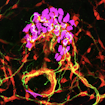On June 12 and 13, the Simons Foundation Autism Research Initiative (SFARI) held its second workshop on 16p11.2 deletions and duplications. A total of 62 participants from across the U.S. and Europe attended the meeting.
Deletions and duplications of 16p11.2, a small region of chromosome 16, have been associated with several developmental disorders and intellectual disabilities, many of which have overlapping features with autism; individuals with 16p11.2 deletions or duplications are considered to be at high risk for autism.
Attendees included human geneticists, mouse model researchers, cognitive neuroscientists, clinicians and others. Talks ranged in content from medical phenotypes and clinical variability to neuroimaging findings and genetic variation in individuals carrying the 16p11.2 deletion or duplication, making the meeting a useful venue to discuss a broad swath of issues relevant to 16p11.2.
“This wasn’t your typical meeting where everyone was like-minded,” says John Spiro, deputy scientific director of SFARI and co-organizer of the meeting with Wendy Chung, SFARI’s director of clinical research. “There were people from all different fields and everyone was excited and interested in all the talks because they could shed light on some of their own research.”
“The meeting provided a comprehensive overview of how scientists are approaching a common problem, but with diverse yet complementary tools,” says Chung. The tools and approaches discussed ranged from use of model organisms such as zebrafish and mice, to neuroimaging and human behavior.
During SFARI’s first 16p11.2 meeting in 2012, attendees sought to address major questions in the field: Which genes in the region are most relevant to the phenotype? What accounts for the clinical variability among those with 16p11.2 deletions or duplications? What are potential therapeutic interventions? That meeting was extremely productive in catalyzing the researchers, so SFARI decided to hold another meeting in 2014.
This year’s workshop was nearly twice as large, reflecting an influx of talented researchers to the field, each, for the most part, working to understand a small portion of 16p11.2 phenomena. Presenting new, unpublished work was a requirement for attendance.
A major development discussed was the advent of three separate mouse models to study the region. However, some notable differences between the findings produced by the different models were evident. One significant outcome of the meeting, explains Spiro, was the agreement among the mouse model groups to work through important differences in their findings, perhaps working toward a review article of their combined findings.
Potential treatments were another topic of discussion. “There are really important decisions being made regarding families and potential treatment options,” says Spiro. “And these decisions are dependent on people knowing certain answers that may come from other 16p11.2 research groups. We want the different groups to benefit from each other at these meetings because the questions they’re asking could have big consequences for families.”
Specifically, the Simons Foundation has recently acquired the rights to arbaclofen, and studies in mouse models of 16p11.2 could help determine whether it might be a useful drug in humans.


